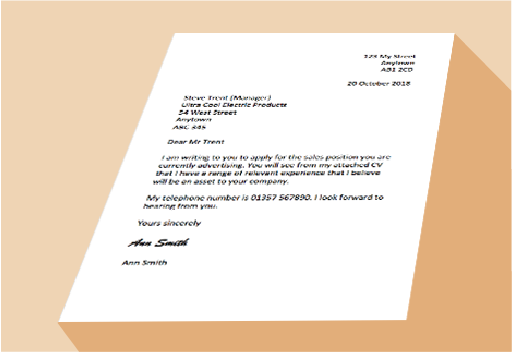5.2 Writing letters
Despite the widespread use of email, the letter remains an important form of communication. We tend to use letters when it seems important to say something in writing. That might be:
- for legal or official reasons, e.g. communicating with a solicitor or bank
- to put a case more strongly and to have a written record, e.g. complaining about a faulty product
- to deal clearly with a complicated issue, e.g. arrangements while someone is on holiday
- just because it is hard to reach the person otherwise, e.g. the head teacher of a school.
Always keep formal letters short and to the point. Use a polite, formal style and clear, simple language. Where possible, use a heading to identify the topic of your letter. Use a separate paragraph for each main point.
Formal (or business) letters have a clear, three-part structure:
- Why you are writing.
- What the other person needs to know.
- What action you want the other person to take.
Below is the usual format of a formal letter:
- The writer’s address is in the top right-hand corner.
- The date is underneath that address.
- The address of the person/company being written to is lower down on the left-hand side.
- The greeting is underneath that address.
- The body of the letter follows the greeting.
- The closing or sign-off is on the left-hand side, underneath main text.
- Your signature (if hand-written) is underneath.
- Your name is underneath that.
The usual greetings used in a formal letter are ‘Dear Sir/Madam’. If you know the person’s name, it’s ‘Dear’ and then their name.
If you use Sir/Madam, the closing should be ‘Yours faithfully’. If you use their name, the closing should be ‘Yours sincerely’. It is becoming more acceptable to break these rules and it is quite common to end even formal letters with ‘Kind regards’ or ‘Yours truly’. However, when asked to write a formal letter it is sensible to follow the traditional rules.
Activity 30 Identifying the features of a letter
Below is a letter with pointers to various features. Drag and drop each label to the appropriate slot.
Discussion
Another example of a letter – this time with a heading – is given in the discussion of Activity 32.
Activity 31 Planning a letter
Imagine you have signed a contract to work on a cruise ship for 18 months. The job starts in six weeks and you are excited about seeing places like the Greek islands, the Caribbean, Hong Kong and the Far East!
To help pay the mortgage (£450 a month), you plan to let your house while you are away. Several estate agents say it will be easy to find a tenant among staff at the nearby hospital or university. They think you can get at least £550 a month, perhaps more from a group of students.
Your only worry is whether the terms of your mortgage allow you to let your house. When you contact your bank, the manager, Mrs Knightsbridge, asks you to make a formal request in writing.
Try planning a letter to your bank, to inform them of your plans and to check that they have no objection to you letting your house. Make a list of the essential information that you must include and optional information that you might include.
Discussion
Here are points you may have wanted to include.
Must include:
- your address
- Mrs Knightsbridge’s name and job title
- the name and address of the bank
- the date
- why you are writing – you want to let your house
- what the bank needs to know:
- you have signed an 18-month contract to work on the cruise ship
- your salary is able to cover the mortgage of £450
- you would like to let the house
- you have been advised the likely rental value is £550 or more
- what action you want the bank to take:
- to confirm that this arrangement is acceptable.
Might include:
- strong rental demand locally due to the hospital and university
- your plans in 18 months’ time, after the contract ends (what happens if you renew the contract?).
Activity 32 Writing a letter
Now try writing a letter to Mrs Knightsbridge formally requesting permission to let your house while you are away. Use your plan from the previous activity to help you.
Hint: When you are writing the letter, try to imagine the dialogue (or conversation) you are having with Mrs Knightsbridge, especially the questions she might want answered.
Discussion
Below you will see one version of the letter to Mrs Knightsbridge. Yours will be a little different. Take a look at it in relation to the following points.
First, examine the layout:
- Have you placed names and addresses in the correct places? The sender’s name and address is shown on the left below but is usually positioned on the right.
- Is your letter properly paragraphed?
Second, look at the content:
- Does your letter follow the structure for a formal letter?
- Does it first explain why you are writing, then give the reader (in this case Mrs Knightsbridge) the information they need to understand the situation?
Finally, have you explained what action you want your reader, Mrs Knightsbridge, to take?
Here’s the letter.
Pat Smith
14 Acacia Avenue
Trumpton Medley
Herts TM2 4SD[Today’s date]
Mrs Knightsbridge
Branch Manager
Oxford and Cambridge Bank
14 The Crescent
London NW1 3RR
Dear Mrs Knightsbridge
Re: account number H122345EE request to let property
I am writing further to my telephone call yesterday to request permission to let 14 Acacia Avenue.
I have recently accepted an appointment as On-board Entertainment Co-ordinator with Deluxe Cruise Lines. My contract is for 18 months (I enclose a copy for your information) and I am due to take up my new post at the end of next month. The job requires me to live on board ship and I will be away from 14 Acacia Avenue for the length of the contract. During this period, I propose to let the property.
I have already spoken to several local estate agents who assure me it will be easy to find suitable tenants from the university or nearby hospital. To protect the property in my absence I would use the services of a managing agent.
I understand that, in the current market, the property will command a monthly rental of £550. Please note that whether I let the property or not, I shall continue making mortgage payments (£450 a month) by direct debit.
I would be grateful if you could confirm that you have no objection to my letting 14 Acacia Avenue while I am abroad.
Yours sincerely
Pat Smith

